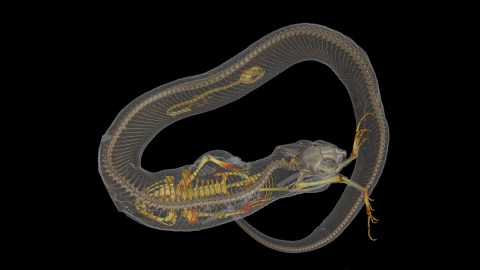Geek Out on Some Amazing 3D Models of Vertebrate Species

On September 1, launched a $2.5 million project called “Open Exploration of Vertebrate Diversity in 3D” or as many scientists know it – the “scan-all-vertebrates” project.
Sponsored by the National Science Foundation, spearheaded by the University of Florida and main researcher David Blackburn, a herpetologist at the Florida Museum of Natural History in Gainesville, the project will be a collaboration between 16 universities and museums across the U.S. and will continue for four years. The result will be a free and open online database of 3-D scans revealing the internal anatomy of more than 20,000 vertebrate species.
Cordylus namakuiyus skeleton by UF Herpetology on Sketchfab
“The vision is to get specimens off a shelf, into as many hands as possible, and into the context of big-scale research questions,” Blackburn says for Science.
The project will set up a network of digitization centers across the U.S., where fluid-reserved specimens, with their innards intact, will be brought in from museums and scanned.
Smaug barbentonensis / Florida Museum of Natural History / Ed Stanley
The researchers will use x-ray computed tomography (CT) scanning to generate high-resolution digital anatomical data. Some of the species will also undergo a dyeing treatment to boost the contrast on soft tissues and provide clear views of the muscles, circulatory system and brain.
Details of internal anatomy / Florida Museum of Natural History / Ed Stanley, David Blackburn
The scans will be hosted on MorphoSource – an on-line platform for 3-D data of biological specimens. Upgrades in the interface and functionality will improve the users’ capacity to explore the media and conduct scientific studies with it, as well as engage educators and students.
Smaug giganteus by UF Herpetology on Sketchfab
The ultimate goal of the project is to catalyze research activity and help scientists integrate their work across various fields like taxonomy, evolution, developmental biology, comparative physiology, functional anatomy, paleontology, and ecology.
Heleophrynidae: Hadromophryne natalensis by UF Herpetology on Sketchfab
But this unique database can aid other disciplines as well. Science writes, for example, Cassandra Donatelli at Tufts University is using the 3-D models to help her design an energy-efficient robot for underwater exploration by mimicking the joints and movements of long and slender fish.
Lanthanotus boeneensis – the only living species in its family / Florida Museum of Natural History / Ed Stanley
As the Florida Museum wrote, announcing the news: “With virtual access to specimens, researchers could peel away the skin of a passenger pigeon to glimpse its circulatory system, a class of third-graders could determine a copperhead’s last meal, undergraduate students could 3-D print and compare skulls across a range of frog species and a veterinarian could prepare for a surgery on a giraffe at a zoo.”
… And a regular nerd could blissfully geek out for hours, searching for, let’s say, anatomical similarities between Daenerys’ dragons and various reptile species.





